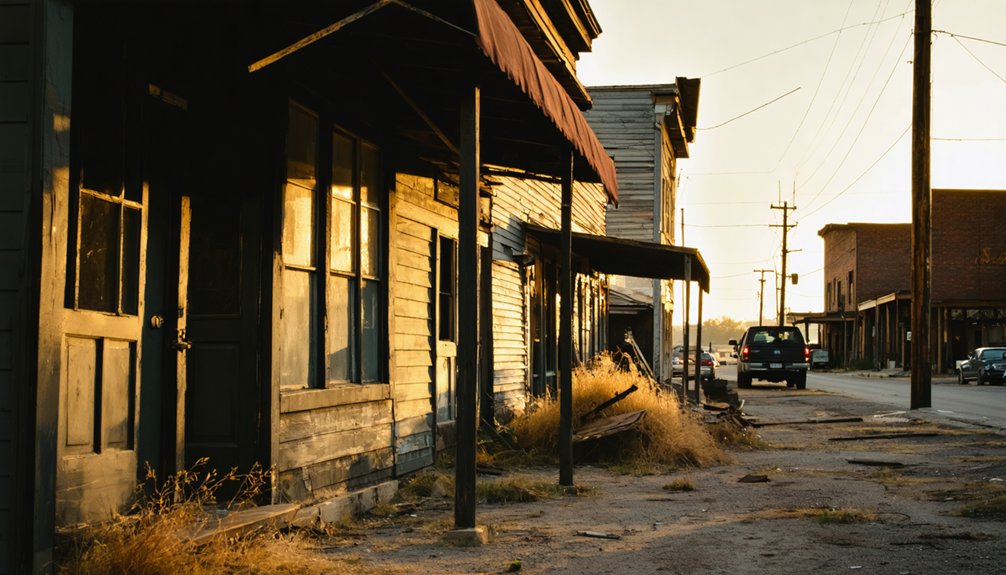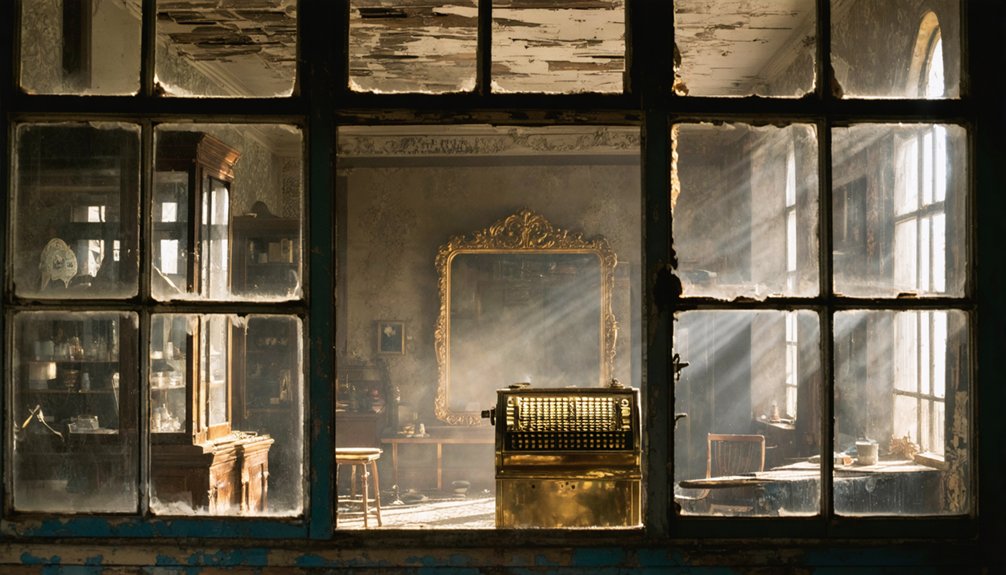To capture hauntingly authentic Victorian ghost town landscapes, you’ll need historical research, masterful lighting techniques, and strategic composition choices. Shoot during golden hour to enhance atmospheric qualities, utilize leading lines from weathered structures, and document forgotten artifacts with respectful attention to detail. Always prioritize safety with proper gear and secure necessary permissions before exploring abandoned properties. The secrets of these silent witnesses to America’s industrial past await your careful documentation.
Key Takeaways
- Visit during golden hour to create dramatic shadows and warm light that accentuates weathered Victorian architecture.
- Frame compositions through broken windows or doorways to create depth and evoke a sense of forgotten history.
- Photograph found artifacts in their original context to tell authentic stories of the past inhabitants.
- Use leading lines like deteriorating staircases or overgrown paths to draw viewers into your eerie ghost town compositions.
- Always obtain proper permits and wear protective gear when exploring potentially hazardous abandoned structures.
Researching Ghost Town History for Authentic Victorian-Era Shots
When capturing the essence of Victorian ghost towns, thorough historical research becomes your cornerstone for creating authentic period photographs. Begin by exploring historical archives that document mining booms and industrial expansions from the 1850s-1890s that birthed these settlements.
Identify towns with well-preserved Victorian architecture—look for wooden storefronts, ornate facades, and period-specific structural elements. Examine local legends and documented catastrophes that hastened abandonment; these narratives inform the emotional quality of your compositions. Ghost towns like Bodie, California offer remarkable photography opportunities with its well-preserved buildings and artifacts maintained as a State Historic Park.
The soul of Victorian ghost towns lives in weathered facades and whispered tales of sudden exodus.
Study period maps to understand original town layouts, helping you frame shots that respect historical accuracy. Focus on key structures like saloons, jails, and churches that defined Victorian communities.
Pay attention to preservation states—some sites offer pristine examples while others present atmospheric decay that tells its own compelling story of abandonment. Consider exploring with a companion as having another person can provide additional safety while navigating potentially hazardous historical structures.
Mastering Moody Lighting Techniques for Abandoned Structures
How masterfully you capture Victorian ghost towns depends largely on your command of atmospheric illumination. Embrace the golden hours when angled sunlight penetrates dilapidated windows, revealing texture and decay with emotional depth.
Position your camera to exploit natural light patterns while managing exposure contrasts between bright windows and shadowy interiors. In darker spaces, portable LED panels with adjustable color temperature provide controlled lighting nuances without harsh hotspots. Mount these magnetically for flexible positioning in confined areas. The Lume Cube Panel Mini has proven invaluable for providing even light dispersion in abandoned buildings where natural light is scarce.
For dramatic atmospheric ambiance, backlight architectural features to create haunting silhouettes. Combine flashlights with long exposures for selective light painting that highlights Victorian details while maintaining shadow dynamics. Night photography enhances the mysterious ambiance of these abandoned settings, creating an otherworldly quality impossible to achieve in daylight.
Add diffusers to soften artificial illumination, reducing harsh shadows inside crumbling interiors. Always use tripods for stability during the extended exposures necessary to capture the soul of these forgotten places.
Composition Strategies That Enhance the Sense of Abandonment
Effective composition transforms mundane Victorian ghost town photography into haunting visual narratives that resonate with viewers.
When framing your shot, utilize leading lines like crumbling staircases or overgrown pathways to draw the eye deeper into the scene’s isolation.
Symmetrical compositions of centered doorways or balanced facades create an unsettling order amidst decay, heightening the eerie stillness.
Frame your subjects through broken windows or weathered doorframes to establish depth and context while suggesting confinement.
Don’t hesitate to incorporate negative space—vast skies or empty streets—to emphasize the desolation.
Position lone structures off-center to highlight their abandonment while applying the rule of thirds for more compelling compositions.
Seek out repeating patterns in Victorian architecture, like rows of windows or ornate columns, to create visual rhythm that contrasts beautifully with the surrounding decay.
Consider converting your images to black and white to flatten contrast and give them an aged, timeless quality that enhances the ghostly atmosphere.
Storytelling Through Forgotten Artifacts and Personal Remnants
While masterful composition frames the architectural remains of Victorian ghost towns, the true soul of these abandoned places lies in their forgotten artifacts and personal remnants.
These weathered objects—rusted wagons, faded photographs, handwritten notes—create profound emotional connections with viewers who glimpse the lives suddenly interrupted. The Victorians’ deep fascination with ghosts influenced how we perceive these abandoned spaces today.
When photographing these narrative anchors, use selective focus to isolate a child’s toy against crumbling floorboards or position your camera to capture how nature reclaims a family’s dining table.
The artifact symbolism intensifies when you frame items within their environmental context: a pocket watch half-buried in sand speaks volumes about time’s passage.
Objects tell stories beyond words when photographed where they fell—environmental context transforms artifacts into powerful metaphors.
Always preserve authenticity by photographing objects as found.
Soft natural light filtering through broken windows will enhance textures while maintaining the respectful documentation these silent witnesses to Victorian life deserve.
Exploring during the early morning hours, as Romain Veillon does, can reveal the most captivating light for these forgotten treasures.
Essential Safety Gear and Legal Considerations Before Your Shoot
Victorian ghost town photography demands three essential preparations beyond your artistic vision: proper safety equipment, thorough legal research, and extensive risk assessment.
Before venturing into these time-frozen domains, equip yourself with heavy-duty boots, durable gloves, and proper respiratory protection against hidden hazards like asbestos or toxic mold.
Your safety equipment should include reliable illumination—headlamps and backup flashlights—to navigate shadowy interiors where natural light fails to penetrate.
Equally vital is securing legal permissions before exploring these historical treasures. Research property ownership, obtain necessary permits, and respect posted restrictions. Always be conscious of structural integrity when entering any abandoned building, as deteriorating floors and ceilings pose serious safety risks.
Many seemingly abandoned sites remain private property or protected landmarks.
For maximum visibility in the darkest corners, select flashlights with adjustable focus that can provide both wide flood illumination and concentrated beams.
Always travel with companions, maintain communication devices with charged batteries, and prepare an emergency plan.
The freedom to capture these hauntingly beautiful locations comes with the responsibility to preserve both yourself and these irreplaceable historical records.
Frequently Asked Questions
How Do I Handle Unexpected Visitors or Locals During Ghost Town Shoots?
When California photographer Max Healy encountered a landowner in Bodie, he greeted him respectfully. During unexpected encounters, introduce yourself, explain your purpose, and follow local etiquette—they’ll often share valuable historical insights.
Which Post-Processing Techniques Best Preserve Authentic Victorian Color Palettes?
You’ll preserve Victorian authenticity by desaturating modern tones, applying warm sepia-tinted vintage filters, and using color grading that emphasizes muted greens, burgundies, and ochres while maintaining subtle tonal shifts throughout your composition.
Can Drones Enhance Ghost Town Photography Without Disturbing Historical Sites?
You’ll find drone regulations prohibit flights at most historic sites. When permitted, aerial perspectives reveal unseen structural relationships, but you must secure proper authorization to avoid compromising these fragile Victorian remnants’ authenticity.
What Weather Conditions Create the Most Compelling Ghost Town Atmospheres?
Overcast skies and foggy mornings yield the most haunting ambiance. You’ll find mist obscuring distant structures while diffused light reveals weathered textures. Rainstorms create reflective surfaces, while golden hour casts dramatic, elongated shadows.
How Do I Ethically Photograph Human Remains Sometimes Found in Abandoned Towns?
Just when you’re exploring, you’ll face ethical considerations requiring you don’t photograph human remains. Instead, document context through sketches, notify authorities, and prioritize respectful representation over sensationalism. Always seek proper consent.
References
- https://pamphotography.blog/2023/07/08/how-to-photograph-ghost-towns/
- https://blog.youtalent.com/techniques-adding-eerie-atmosphere-abandoned-villages-or-towns-landscape-compositions/
- https://www.photocascadia.com/for-the-love-of-ghost-towns/
- https://www.artsy.net/article/artsy-editorial-photographers-capture-haunting-beauty-ghost-towns
- https://en.wikipedia.org/wiki/List_of_reportedly_haunted_locations
- https://photzy.com/photographing-the-old-and-abandoned/
- https://cdn.bookey.app/files/pdf/book/en/ghost-town-treasures.pdf
- https://olafphotoblog.com/tag/ghost-town/
- https://en.wikipedia.org/wiki/Gothic_romance
- https://www.worthingcameraclub.org.uk/wp-content/uploads/2024/04/Victorian-Ghost-Photography.pdf



